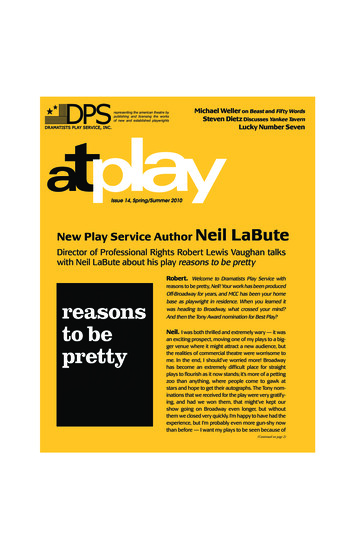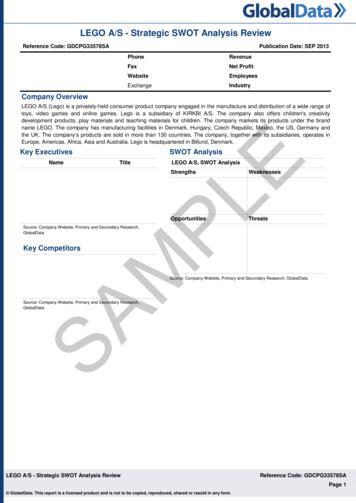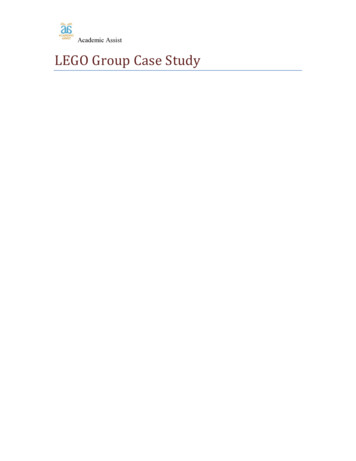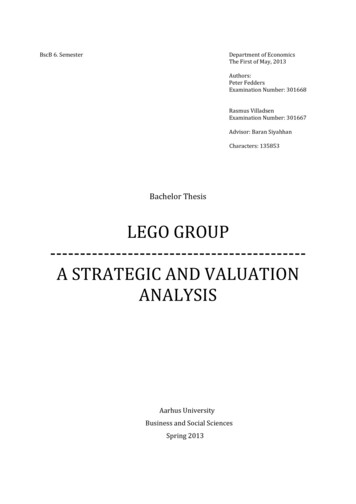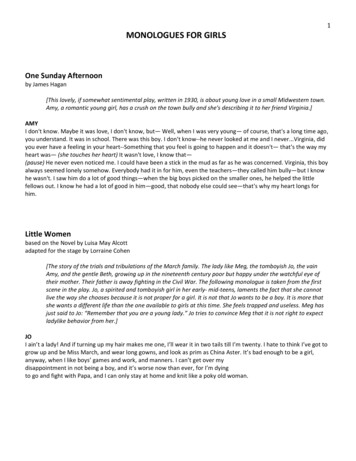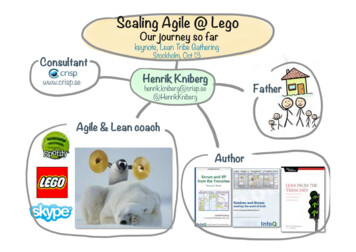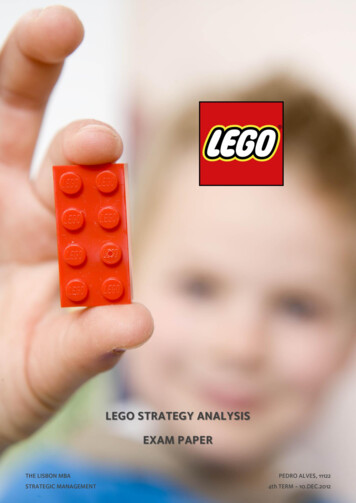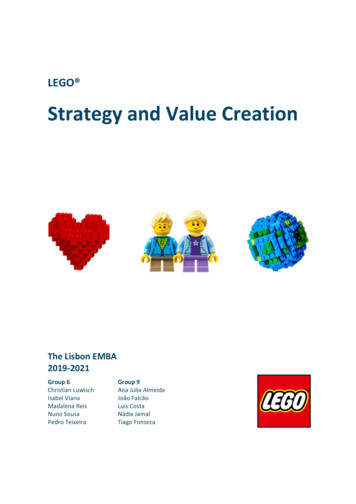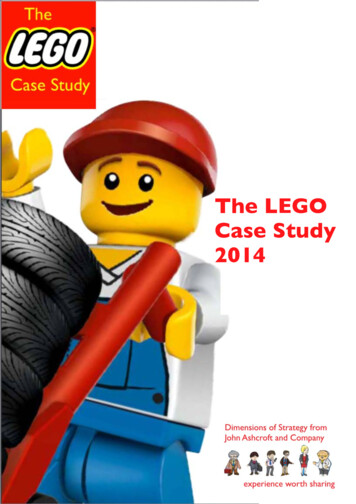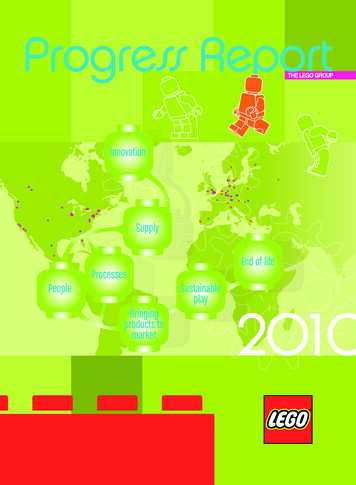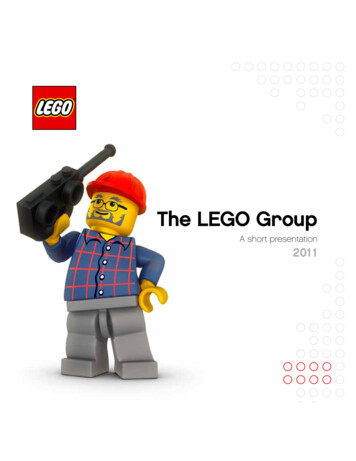
Transcription
The LEGO GroupA short presentation2011
2THE LEGO GROUP 2011
ContentsIt all began in 1932 . . . . . . . . . . . . . . . . . . . . . . . . . . . . . . . . . . . 4The LEGO Group in key figures . . . . . . . . . . . . . . . . . . . . . . 5Focus on growth . . . . . . . . . . . . . . . . . . . . . . . . . . . . . . . . . . . . 6Organization . . . . . . . . . . . . . . . . . . . . . . . . . . . . . . . . . . . . . . . . . 7Idea and production . . . . . . . . . . . . . . . . . . . . . . . . . . . . . . . . . 8LEGO products for all children . . . . . . . . . . . . . . . . . . . . . . .9The LEGO History - In Short . . . . . . . . . . . . . . . . . . . . . . . . . . 11The minifigure . . . . . . . . . . . . . . . . . . . . . . . . . . . . . . . . . . . . . . . . 16LEGOLAND parks . . . . . . . . . . . . . . . . . . . . . . . . . . . . . . . . . . . 18LEGO Community . . . . . . . . . . . . . . . . . . . . . . . . . . . . . . . . . . . . 19Learning through play . . . . . . . . . . . . . . . . . . . . . . . . . . . . . . . . 21Fun LEGO Facts . . . . . . . . . . . . . . . . . . . . . . . . . . . . . . . . . . . . 22Using the LEGO brand name . . . . . . . . . . . . . . . . . . . . . . . 24THE LEGO GROUP 20113
It all beganin 1932In 1932 Ole Kirk Kristiansen, a Danish joiner and carpenter, began making wooden toys. The business he established laterpassed from father to son, and today the founder’s grandson,Kjeld Kirk Kristiansen, and his children own the LEGO Group.In 1958 Godtfred Kirk Christiansen, son of Ole Kirk Kristiansen,made what would prove to be an extremely wise decision.On January 28, 1958, at precisely 13.58 he submitted a patentapplication for the LEGO brick that was – literally – to proveto be the cornerstone of a toy fairy tale. At the start of thenew millennium the LEGO brick was acclaimed “Toy of theCentury” – first by Fortune Magazine and later by the BritishAssociation of Toy Retailers.It was Founder Ole Kirk Kristiansen himself who hit upon theLEGO name in 1934. He took the first two letters of the Danishwords LEG GODT, meaning “play well”, and combined them– quite unaware that one meaning of the word in Latin is . “Iput together”. To this very day “LEGO” is both the name andthe concept behind the company. Play is a key element inchildren’s growth and development, and play stimulates theimagination, the emergence of ideas, and creative expression.The aim of the company’s products is to “inspire and developthe builders of tomorrow”, and all products are based onthe underlying philosophy of learning and development –through play. It is the LEGO philosophy that “good qualityplay” enriches a child’s life – and lays the foundations for lateradult life.True to its motto “Only the best is good enough”, the LEGO4THE LEGO GROUP 2011Group has been emphasizing the importance of high qualitysince 1932. This approach has brought consumers back toLEGO products time and again. At the same time the LEGOsystem means that many thousands of building elementscan be easily combined in innumerable ways – and just asreadily dismantled again. The more LEGO bricks you have,the more fertile your creativity can become, and there arehours of play in the LEGO brick that you don’t find elsewhere.Child’s play is an everchanging world, and the company’sproduct development departments therefore work systematically with the evolution of play themes and product linesbased on research among children and parents into thingslike play habits, family patterns and housing conditions. Inaddition, the combination of a structured system, logic andunlimited creativity encourages the child to learn throughplay in a wholly unique LEGO fashion. At a time of growingdemand upon children’s capacity for learning and their abilityto solve complex problems, LEGO toys are perfectly createdfor the child of tomorrow. It is for this reason that the LEGOsystem is frequently cited by many leading organisations andindividuals as a specially creative play material used in learning contexts by institutions and schools throughout the world.The child of the future will have plenty of things to play with.Consumer electronics is a tough competitor to traditionaltoys. But the LEGO Group is in no doubt that the LEGO brickwill continue in future to be relevant to children of all ages. Aworld of imagination and total absorption. Putting two LEGObricks together is intuitive and delivers the spontaneous joyof creation which can be supplemented – but never replaced– by virtual experiences.
The LEGO Groupin key figuresThe strong growth achieved by the LEGO Group in recentyears continued at the same pace in 2010.The result before tax - a surplus of DKK 4,889 million - exceeded all expectations for the year, and the LEGO Group’s netsales rose by 37.3% from DKK 11,661 million in 2009 toDKK 16,014 million in 2010.Particularly the markets defined by the LEGO Group as special growth areas, the USA, Great Britain, Russia and EasternEurope, have contributed to the extensive growth, but all theLEGO Group’s markets gained market shares in a slightlyincreasing global toy market.The classic product lines such as LEGO City, LEGO DUPLO and LEGO Star WarsTM created the highest sales in 2010. However, nearly all product lines showed higher increases in 2010than expected.Today the LEGOGroup is the thirdlargest toy manufacturer in terms of sales:1.2.3.4.5.MattelHasbroThe LEGO GroupBandai-NamcoTOMY-TakaraFINANCIAL HIGHLIGHTSTHE LEGO GROUP(DKK million)Income Statement:RevenueExpensesOperating profit before special itemsSpecial itemsFinancial income and expensesProfit before income taxNet profit for the yearEmployees:Average number 1,2811,2908,3657,2865,3884,1994,908THE LEGO GROUP 20115
Focus on growthThe LEGO Group has seen continued growth for severalyears, and sales have increased by double-digit growth rates.This has happened in a global toy market characterized bystagnation for years.The LEGO Group expects continued growth in sales.The foundation for this growth is a constant focus on thecompany’s core products and markets.In addition, the LEGO Group constantly endeavours to develop the way the collaborative work of all the departmentswithin the LEGO Group comes together in a unique operational system to ultimately design, manufacture, plan, sell anddistribute products to customers and consumers. The LEGOGroup calls this the “Operating Model”.On the basis of these core activities, seven growth initiativeshave been defined: Grow market share in USAUSA is the world’s largest market for toys, and the LEGOGroup has dramatically increased its market share in recentyears, to approximately five per cent at the end of 2010.The LEGO Group believes this share can be further increased in the coming years.6THE LEGO GROUP 2011 Grow market share in Eastern EuropeThe toy market in Eastern Europe is experiencing rapidgrowth, and the LEGO Group aims to continue to expand itsstrong position on these markets. Seed “emerging markets”Markets such as China, Mexico, Brazil and India areexpected to see strong growth in the future, and the LEGOGroup plans to invest in developing them. Seed new conceptsIn addition to ongoing product development based on theexisting core portfolio, the LEGO Group will develop innovative new products which are “obviously LEGO products, butnever seen before”. An example of such new products is theLEGO Games board-game series launched in 2009. Expand “direct to consumer” activitiesThe LEGO Group currently has direct contact to consumers through its own sales channels, clubs, collaborationprograms, etc. The aim is to get even closer to consumersthrough greater contact and by expanding offers availabledirect to consumers. Expand LEGO EducationThe aim is to create growth in the area of educationalmaterials for preschools, schools and educational institutions all over the world. Develop digital businessThe LEGO Group currently operates on digital platformsthrough the LEGO.com website and video games. Digitalbusiness has been further expanded, in particular throughLEGO Universe – the first MMOG (massively multiplayer online game) from the LEGO Group, launched in 2010.
OrganizationThe LEGO Group today is owned by the third and fourthgenerations of the Kirk Kristiansen founding family: Kjeld KirkKristiansen and his three children.Ownership of the LEGO Group is handled through theinvestment company KIRKBI and the LEGO Foundation.KIRKBI owns 75% of the LEGO Group. KIRKBI also owns a 36%shareholding in Merlin Entertainments Group whose activitiesinclude running the LEGOLAND parks.The remaining 25% of the LEGO Group is held by the LEGOFoundation.Read more at:www.KIRKBI.dkwww.LEGO-fonden.dkChief Executive OfficerJørgen Vig KnudstorpGSCExecutiveVice PresidentBali PaddaM&PExecutiveVice PresidentMads NipperCEDExecutiveVice PresidentLisbeth V. PallesenCCExecutiveVice PresidentChristian IversenGlobal Supply Chain (GSC)GSC is responsible for theGroup’s supply chain, fromprocurement and production - including moulding,decoration and packing – toshipping and distribution tothe retail trade.Markets & Products (M&P)M&P has global responsibility for developmentof new products for retailcustomers, development ofmarketing materials, globalmarketing and sales to retailcustomers worldwide.Community, Education& Direct (CED)CED is responsible fordirect contact with consumers as well as sales viaLEGO brand retail stores,online sales and mail order.In addition, this businessarea is responsible fordigital business. And CEDis also responsible forthe Group’s development,marketing and sale ofeducational materials.Corporate Center (CC)CC covers the strategicand supportive functions:Corporate IT, Corporate HR,Corporate Communications, Corporate Governance & Sustainability,Continuous Improvement,LEGO Service Center andGovernmental Affairs.CFChief FinancialOfficerSten DaugaardCorporate Finance (CF)CF is responsible for financialmanagement and controllingas well as follow up on business planning and strategicinitiatives.THE LEGO GROUP 20117
Idea andproductionHow LEGO bricksare madeConcept and product development takes place primarilyat the company’s Billund headquarters (Denmark) – but theLEGO Group also has listening posts in Munich, Los Angelesand Tokyo in order to monitor the latest trends. The creative core is made up of 120 designers representing about 19different nationalities. Most of the designers have trained atdesign or art schools in various parts of the world. The LEGOGroup, however, does not formally stipulate that its designersmust have such a training; selection is based on hands-onwork and face-to-face interviews.During the moulding process, the plastic is heated to 230310 C until its consistency is about that of dough.It is then injected into the moulds at apressure of 25-150 tons, depending onwhich element is being produced.On an average, it takes five to tenseconds to cool and eject newelements. The moulds used in production are accurate to within fivemy ( 0.005 mm), and the accuracy ofthe moulding process means that only 18elements in every million produced fail tomeet the company’s high quality standard.All LEGO elements are fully compatible,no matter when they were made during the period from 1958 until now orby which factory.LEGO bricks are manufactured at the Group’s own factoriesin Denmark, Hungary, Czech Republic and Mexico. The locations have been selected in order to be close to the Group’smost important markets in Europe and the USA. In addition,elements and finished products are procured from externalsuppliers. In 2010 more than 36 billion elements were made,equivalent to approx. 68,000 elements a minute – or 1,140 elements every second.There are approx. 4,000 different elements in the LEGO range– plus 58 different LEGO colours. Each element may be soldin a wide variety of different colours and decorations, bringingthe total number of active combinations to approx. 8,000.8THE LEGO GROUP 2011
LEGO productsfor all childrenThe range embraces products for all children. The entireproduct portfolio is graduated in its challenge to reflect thefact that children grow older and develop. LEGO productscan be grouped into a number of categories:Pre-school productsPre-school products are the category for children who haven’tyet started school. The products are specially developed tocater for the capabilities of the youngest children – encouraging them through creative play to use their hands anddevelop their motor skills. Today LEGO DUPLO comprisesboth loose bricks – encouraging the child to build entirelywhat comes into its mind – and play themes – for example,airport, train and castle. The series is graded in difficulty forchildren aged 18 months to six years. Safety and quality arekey features of the Pre-school range. The elements are largeenough for children under three years to play with withoutswallowing them – and thanks to the way they have beenmoulded no bits can become loose.Bricks & MoreBricks & More is the name given to sets or buckets withtraditional LEGO bricks and special parts such as windows,wheels and roof tiles. No building instructions are neededhere – just a bit of imagination. With Bricks & More you canbuild what you want. Run out of ideas? There are bookletsenclosed – with illustrations to feed the active mind. Bricks &More is available in DUPLO bricks and standard LEGO bricks.Play themesPlay themes are all those products that are built up around astory. For example, there are themes such as fire station, police, airport, knights’ castle, racers – and many more. As wellas enjoying building, the child can spend many hours playingwith the finished models.Licensed productsLicensed products are play themes based, for example, onmovies or books for which the LEGO Group ha
The LEGO Group in key Þgures The strong growth achieved by the LEGO Group in recent years continued at the same pace in 2010. The result before tax - a surplus of DKK 4,889 million - exceed - ed all expectations for the year, and the LEGO GroupÕs net sales rose by 37.3% from DKK 11,661 million in 2009 to DKK 16,014 million in 2010.
